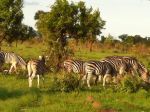 I haven’t posted about elephants since March 6. Today’s news story about an elephant trampling a poacher to death in Zimbabwe caught my attention. Within the article are some worthwhile facts; The Elephant Advocacy League estimates that about 40,000 elephants are killed annually. On May 6, 26 elephants were killed in Dzanga-Ndoki National Park in the Central African Republic. This is a world heritage site. In Cameroon 40 endangered forest elephants were killed in 2 national parks as reported Mar. 27. In Kenya, 24 have been killed in the Tsavo conservation area consisting of 2 national parks. In Tanzania, there are allegations of 70 carcasses in Selous, the world’s largest game reserve and allegations of government worker involvement or complicity. It appears that the national park / game reserve protection model is failing miserably.
I haven’t posted about elephants since March 6. Today’s news story about an elephant trampling a poacher to death in Zimbabwe caught my attention. Within the article are some worthwhile facts; The Elephant Advocacy League estimates that about 40,000 elephants are killed annually. On May 6, 26 elephants were killed in Dzanga-Ndoki National Park in the Central African Republic. This is a world heritage site. In Cameroon 40 endangered forest elephants were killed in 2 national parks as reported Mar. 27. In Kenya, 24 have been killed in the Tsavo conservation area consisting of 2 national parks. In Tanzania, there are allegations of 70 carcasses in Selous, the world’s largest game reserve and allegations of government worker involvement or complicity. It appears that the national park / game reserve protection model is failing miserably.
No, that last statement is incorrect. The park/reserve system is doing the job of separating day to day wildlife-human interaction. Wildlife wandering in villages or trampling through farms or agricultural crops is a poor mix. And in my first paragraph I ignored parks that are too successful at protecting elephants. Think of Kruger National Park and of Chobe where there are now so many elephants that park integrity is threatened by the damage elephants do to vegetation. I have read that in parts of Zimbabwe, elephants die as their food supply is now too distant from watering holes. So the problem is not the parks and reserves, the problem is with adequate enforcement of protective measures, and yes the problem is that sometimes wildlife management of expanding populations may also be required. For additional thoughts, views and information about poaching, I refer you to 2 blog posts by Rory Young, “What would effectively stop elephant poaching in Africa?“, and “How do you deal with animal poachers?” [WARNING – graphic images not for children].




